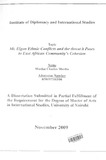| dc.description.abstract | Ethnic conflicts may have devastating effects to the economic, political and socio-cultural wellbeing of a state. These effects may spread to the neighbouring states to the extent that the relationship of such a state and her neighbours are affected. There are a number of conflicts along some of the Kenyan borders. This study focused on Mt. Elgon ethnic conflicts. The main objective was to find out what exactly is the main cause of these conflicts and establish the ripple effect to the neighbouring countries and by extension the entire East African region.
The ethnic conflicts within Mt. Elgon area take two forms. The first one is inter-tribal and this is mainly between the Bukusu tribe and the Sabaot. It takes the dimension of which tribe is superior to the other and which tribe is benefiting at the expense of the other as far as then resources within the region is concerned. It hardly resorts to armed conflict but it was quite clear during the interview that there exists a cold war between these two tribes.
The other form is inter-clan. Within the Sabaot tribe, there are a number of clans. These clans are fighting over land. Some clans feel that there has not been justice in land allocation. This has resorted to armed conflict. In fact some tribes went ahead to form a militia group - the Sabaot Land Defence Force - to fight for what they thought was unjust to them. These conflicts have spread to the neighboring country Uganda since each of those tribes and clans have got their counterparts in Uganda who also side with them.
The conflicts have also led to other tribes, mainly from Uganda, taking advantage to come and raid cattle. This has made the relationship between the citizens of the two states at the border sour. This clearly jeopardizes the East African Community's vision of having a political federation by the year 2013, since a stable political federation is dependant upon a good relationship among citizens of the member states. The situation is made worse bearing in mind that Mt. Elgon Ethnic Conflicts are not the only intra-state conflicts that has a spillover effect. There others like between the Karamoja and the Turkana along the Kenya Uganda border, the Kisii and the Maasai, the Kuria and the Maasai, the Kuria and the Luo, all along the Tanzania Kenya border.
There are many dimensions and actors to these conflicts. However it is clear from this paper that Mt. Elgon conflict is resource based, mainly land. Managing it will increase the cohesion of the people around the region and this will have a positive effect to their counterparts on the other side of the border. This is why, at the end of the paper, suggestions have been provided on the effective ways to manage the conflict. | en_US |

